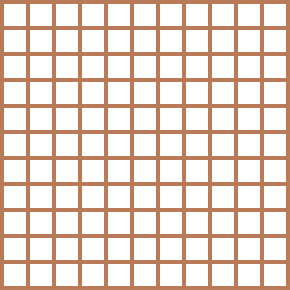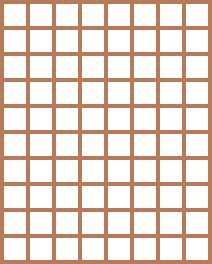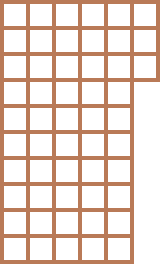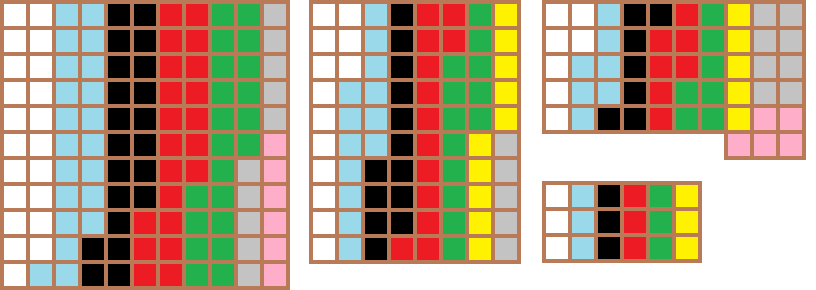Pattern Recognition #197 - A New Set - Colour Distribution
Features Opinion Pattern Recognition
berryjon
27 May 2021
403 views
27 May 2021
403 views
Hello everyone! This is Pattern Recognition, TappedOut.Net's longest running article series as written by myself, berryjon. I am something of an Old Fogey who has been around the block quite a few times where Magic is concerned, as as such, I use this series to talk about the various aspects of this game, be it deck design, card construction, mechanics chat, in-universe characters and history. Or whatever happens to cross my mind this week. Please, feel free to dissent in the comments below the article, add suggestions or just plain correct me! I am a Smart Ass, so I can take it.
OK, so just a heads up, this article it going to talk about rarities (which I've already covered) and will do a lot of graphics to visually show you all how things are going to break down. Here's hoping it looks good to you, because by the time I'm done, I'm pretty sure this will all be visual noise to me.
What you need to understand before we get into this, is that nothing shown here is final. It's the developing of a framework and skeleton for future work, and if the final numbers change from here, then so be it. This is an organic process, and decisions made earlier one do have some flexibility before they become set in place. So, let's get to it, shall we?
SET SIZE
I'll be honest with you, I had this whole spiel lined up about how I wanted to fill three full sheets of unique cards, with 121 Commons, Uncommons and Rares each (because, as I talked about in the Rarity article, Mythics are a con) and that I WOULD SHOW THEM ALL! (insert dramatic thunder here).
However, doing so would just make me look like a bigger ass than I normally am, and that's already pretty big. And besides, I want this to be a nice, playable, "hey, we could totally print this!" set, so doing things like that just shoot myself in the foot.
Besides, this will mean designing lesser numbers of cards, so that saves on that.
Now, to save you all some digging, here is the typical breakdown of a Magic set by rarity:
Commons: 121 cards.

Uncommons: 80 cards

Rares: 53 cards

Mythic Rare: 15 cards.

Now from here, we need to start distributing our colours.
COLOUR DISTRIBUTION
At its simplest, each colour gets an equal share of each set. There have been exceptions in the past, I'm looking at you Torment. However, there are some caveats that I've observed over the years.
First, is that outside of hardcore multi-coloures sets like Ravnica, there are no proper multi-coloured cards at common. They are all mono-colour or colourless (Artifacts or Lands). Secondly, you rarely get colourless cards at Mythic, outside of things like Lithoform Engine or the Eldrazi Titans.
What this means is that we're looking at 20 of each colour and 21 colourless at Common, 11 of each colour, including colourless and Gold, with 3 cards of 'flex' space that can be used to fill in the gaps as needed. At Rares, the numbers go down to 7 of each colour, with 4 cards flex, and at Mythic, we have 2 cards of each colour, 2 gold, and 3 cards for flex.
Graphically speaking, it looks like this:

Now, again, this isn't the final distribution, and I fully expect the common colourless cards to shrink to make room for more coloured cards for example, and I'm equally certain I'm going to trim at least 1 multi-coloured card at Uncommon, perhaps more as well as some colourless to pad out the coloured cards.

So far, so good, right? Well, here's where things really start to get tricky.
COLOUR BREAKDOWN
OK, so when Mark Rosewater writes his 'Nuts and Bolts' articles, he does reveal some interesting facts. Like, for Commons and Uncommons, the general goal is to have a certain percentage of creatures at these rarities to help keep up the whole 'Creatures Matter'! Theme going on with the set, as well as to give Limited and Draft formats something to work with. I like this, and I see no reason to mess around with them.
So, let's look at . Here, we have 20 Commons and 11 Uncommons, and with the percentages given by Rosewater, we're looking at 12 Common Creatures and 7 Uncommon Creatures, with the rest being distributed among instants, sorceries and enchantments.
Now, at this point, I'm going to stop looking at graphics and instead start listing things out. You see, Wizards uses a code system for cards. This system denotes rarity, colour and listing in the database, with creatures coming first. So, for example, CW01 is the first common white card in the set, while MR03 would be the third Mythic card in that set. Mutli-colour cards get a 'Z' as their colour denotation while artifacts and other colourless cards get an 'A'. So, UZ04 would be the fourth multi-coloured card at uncommon, etc. etc...
So at this point, we are left with:
CW01 - Creature CW11 - Creature UW01 - Creature UW08 - Enchantment
CW02 - Creature CW12 - Creature UW02 - Creature UW09 - Instant
CW03 - Creature CW13 - Enchantment UW03 - Creature UW10 - Instant
CW04 - Creature CW14 - Enchantment UW04 - Creature UW11 - Sorcery
CW05 - Creature CW15 - Instant UW05 - Creature
CW06 - Creature CW16 - Instant UW06 - Creature
CW07 - Creature CW17 - Instant UW07 - Creature
CW08 - Creature CW18 - Sorcery
CW09 - Creature CW19 - Sorcery
CW10 - Creature CW20 - Sorcery
For we end up with:
CU01 - Creature CU11 - Enchantment UU01 - Creature UU08 - Instant
CU02 - Creature CU12 - Instant UU02 - Creature UU09 - Instant
CU03 - Creature CU13 - Instant UU03 - Creature UU10 - Sorcery
CU04 - Creature CU14 - Instant UU04 - Creature UU11 - Sorcery
CU05 - Creature CU15 - Instant UU05 - Creature
CU06 - Creature CU16 - Instant UU06 - Creature
CU07 - Creature CU17 - Sorcery UU07 - Enchantment
CU08 - Creature CU18 - Sorcery
CU09 - Creature CU19 - Sorcery
CU10 - Enchantment CU20 - Sorcery
:
CB01 - Creature CB11 - Enchantment UB01 - Creature UB08 - Instant
CB02 - Creature CB12 - Instant UB02 - Creature UB09 - Instant
CB03 - Creature CB13 - Instant UB03 - Creature UB10 - Sorcery
CB04 - Creature CB14 - Instant UB04 - Creature UB11 - Sorcery
CB05 - Creature CB15 - Instant UB05 - Creature
CB06 - Creature CB16 - Instant UB06 - Creature
CB07 - Creature CB17 - Sorcery UB07 - Enchantment
CB08 - Creature CB18 - Sorcery
CB09 - Creature CB19 - Sorcery
CB10 - Creature CB20 - Sorcery
:
CR01 - Creature CR11 - Enchantment UR01 - Creature UR08 - Instant
CR02 - Creature CR12 - Instant UR02 - Creature UR09 - Instant
CR03 - Creature CR13 - Instant UR03 - Creature UR10 - Sorcery
CR04 - Creature CR14 - Instant UR04 - Creature UR11 - Sorcery
CR05 - Creature CR15 - Instant UR05 - Creature
CR06 - Creature CR16 - Instant UR06 - Creature
CR07 - Creature CR17 - Sorcery UR07 - Creature
CR08 - Creature CR18 - Sorcery
CR09 - Creature CR19 - Sorcery
CR10 - Creature CR20 - Sorcery
:
CG01 - Creature CG11 - Creature UG01 - Creature UG08 - Creature
CG02 - Creature CG12 - Enchantment UG02 - Creature UG09 - Enchantment
CG03 - Creature CG13 - Enchantment UG03 - Creature UG10 - Instant
CG04 - Creature CG14 - Instant UG04 - Creature UG11 - Sorcery
CG05 - Creature CG15 - Instant UG05 - Creature
CG06 - Creature CG16 - Instant UG06 - Creature
CG07 - Creature CG17 - Sorcery UG07 - Creature
CG08 - Creature CG18 - Sorcery
CG09 - Creature CG19 - Sorcery
CG10 - Creature CG20 - Sorcery
has slightly different rules as the number of colourless Enchantments, Instants and Sorceries out there I can count on two hands at this point. Rather, I've taken the opportunity to pad out my Flex space some more, card slots that can go into more coloured options as the need arises.
In addition, the five 'Lands' here, represent the five allied lands for the five tribes to better smooth out the mana curves of limited decks. A sixth land will be included for universal colour fixing, such as with Unclaimed Territory.
CA01 - Creature CA11 - Flex UA01 - Creature UA08 - Flex
CA02 - Creature CA12 - Flex UA02 - Creature UA09 - Flex
CA03 - Creature CA13 - Flex UA03 - Creature UA10 - Flex
CA04 - Creature CA14 - Flex UA04 - Non-Creature UA11 - Flex
CA05 - Creature CA15 - Flex UA05 - Non-Creature
CA06 - Creature CA16 - Land UA06 - Non-Creature
CA07 - Non-Creature CA17 - Land UA07 - Non-Creature
CA08 - Non-Creature CA18 - Land
CA09 - Non-Creature CA19 - Land
CA10 - Non-Creature CA20 - Land
CA21 - Land
Multi-Coloured have, again slightly different requirements. Here, we have five colour pairs in the set, so each colour pair will get a creature and a non-creature in that pair at Uncommon to help draft around and shore up the deck. The 11'th space is thus relegated to 'Flex'.
UZ01 - Creature
UZ02 - Non-Creature
UZ03 - Creature
UZ04 - Non-Creature
UZ05 - Creature
UZ06 - Non-Creature
UZ07 - Creature
UZ08 - Non-Creature
UZ09 - Creature
UZ10 - Non-Creature
UZ11 - Flex
Now, looking at these numbers, I can see a few trim points already thanks to all the Flex spacing I've put into my designs so far. First, and most obvious is the five Commons, possibly all ten there if I chose to remove putting lands into the packs here, and instead putting cards like Graypelt Refuge or Blossoming Sands in as the 'Land' slot in the packs. It's an option.
In addition, I can also clear out the 3 current open Flex spaces, the UZ11 and one of the UA's to free up another five spaces for coloured uncommons. Then then I could remove UA03, UA07-UA10 to free up five more.
With these options, I will have no problems adding them to the coloured uncommons, padding them out if needed.
Now, Rares and Mythics work a little differently. They aren't as needful of being so heavily leaning towards creatures, but we still need Rare Creatures to act as 'build-arounds' in terms of capstones for the five tribes and to be representative of the theme - if not their keyword mechanic outright. Here, we will also find our obligatory Rare Dual Lands.
I considered dropping those from the set, but now that I'm breaking things down by colour and spacing, I see how they can fit in. Four empty flex spaces, plus one of the colourless cards can be allocated to the Lands without issue, leaving us with 7 of each colour and 6 colourless.
Now, with five tribes, I'm tempted to trim down the RZ##'s to 01 through 05, one for each Tribe, and then steal three more RA## to give each colour an eighth card, but at this point, I'm not feeling it. In fact, I might put in thouse RA slots an artifact that's designed to work best with the Tribe they are affiliated with, with a sixth artifact....
I have an idea. It's stupid. It's brilliant. And by Urza, I'm going to make it work.
Now, each of the Rare Colours are going to have 2-3 creatures, and the rest non-creature spells. and will trend higher, while the other colours lower. At the Mythic level, it's one or two for each, but I have to remember that here is where the Planeswalkers go. Right now, my pencil'd ideas call for two multi-colour 'Walkers, and one mono-colour walker, so I'll need to keep my options open there. We'll see how it goes, and I'm not going to subject you all to another round of code-sections for this much.
But I do have a better idea of the 'plot' of my set, or at least a driving force for conflict. I did have something before, but that couldn't be as easily put on the cards, so this might be better. I'll need to think it over. I'll also need to start thinking about mechanics and identity.
For now though, here's the updated graphic for colour distribution for the set.

So, join me next week when I talk about something else to buy me time to pursue this new line of thought.
Until then please consider donating to my Pattern Recognition Patreon. Yeah, I have a job, but more income is always better. I still have plans to do a audio Pattern Recognition at some point, or perhaps a Twitch stream. And you can bribe your way to the front of the line to have your questions, comments and observations answered!
JANKYARD_DOG Trust me, there's a LOT of groundwork that goes into a set before any cards actually get designed. Part of your subject is going to come when I get around to looking at surrounding sets and how to cost cards when compared to similar ones in the past.
JANKYARD_DOG says... #1
berryjon Are you or have you perhaps talked about the overall curve of a set? Would be interesting to know how it all comes together.
May 29, 2021 4:39 p.m. Edited.